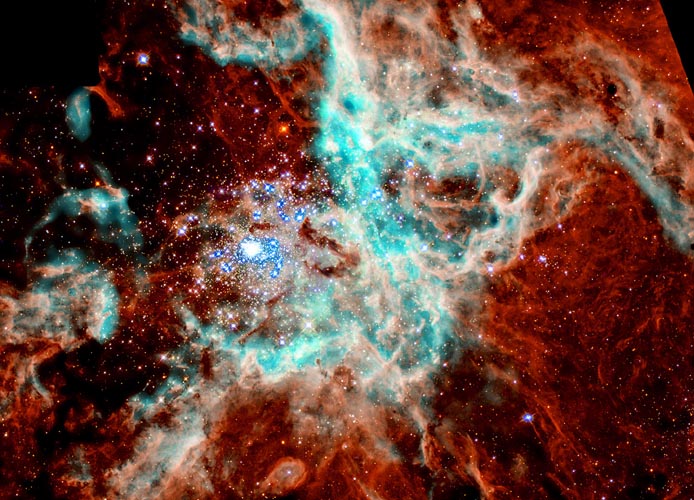
Star-Forming Region
Description: Nebula in the Large Magellanic Cloud
Position (J2000): R.A. 05h 38m 42s b Dec. -69° 06' 03''
Constellation: Dorado
Distance: 52 kpc (170,000 light-years)
Dimensions: 200 light-years wide by 150 light-years high.
Instrument: WFPC2
Exposure Dates: January 1994 - September 2000
Image Credit: NASA, N. Walborn and J. Maíz-Apellániz (STScI), R. Barbá
(La Plata Observatory, Argentina)
Release Date: July 26, 2001
More images: N0650 N1023 N0401 N1105 N0121 N0416 N1117 S0932
ABOUT THIS IMAGE:
NASA's Hubble Space
Telescope has snapped a panoramic portrait of a vast, sculpted landscape
of gas and dust where thousands
of stars are being born. This fertile star-forming region, called the
30 Doradus Nebula, has a sparkling stellar centerpiece: the most
spectacular cluster of massive stars in our cosmic neighborhood of about
25 galaxies.
The mosaic picture
shows that ultraviolet radiation and high-speed material unleashed by
the stars in the cluster, called R136
[the large blue blob left of center], are weaving a tapestry of creation
and destruction, triggering the collapse of looming gas and
dust clouds and forming pillar-like structures that are incubators for
nascent stars.
The photo offers
an unprecedented, detailed view of the entire inner region of 30 Doradus,
measuring 200 light-years wide by 150
light-years high. The nebula resides in the Large Magellanic Cloud (a
satellite galaxy of the Milky Way), 170,000 light-years from
Earth.
Nebulas like 30 Doradus
are the "signposts" of recent star birth. High-energy ultraviolet
radiation from the young, hot, massive
stars in R136 causes the surrounding gaseous material to glow. Previous
Hubble telescope observations showed that R136
contains several dozen of the most massive stars known, each about 100
times the mass of the Sun and about 10 times as hot.
These stellar behemoths all formed at the same time about 2 million years
ago.
The stars in R136
are producing intense "stellar winds" (streams of material traveling
at several million miles an hour), which are
wreaking havoc on the gas and dust in the surrounding neighborhood. The
winds are pushing the gas away from the cluster and
compressing the inner regions of the surrounding gas and dust clouds [the
pinkish material]. The intense pressure is triggering the
collapse of parts of the clouds, producing a new generation of star formation
around the central cluster. The new stellar nursery is
about 30 to 50 light-years from R136. Most of the stars in the nursery
are not visible because they are still encased in their cocoons
of gas and dust.
Some of the nascent
stars are forming in long columns of gas and dust. Previous Hubble observations
revealed that the process of
"triggered" star formation often involves massive pillars of
material that point toward the central cluster. Such pillars form when
particularly dense clouds of gas and dust shield columns of material behind
them from the blistering radiation and strong winds
released by massive stars, like the stars in R136. This protected material
becomes the pillars where stars can form and grow.
The Hubble telescope first spied these pillars of stellar creation when
it captured close-up views of the Eagle Nebula.
The new image of
30 Doradus shows numerous pillars — each several light-years long
— oriented toward the central cluster. These
pillars, which resemble tiny fingers, are similar in size to those in
the Eagle Nebula. Without Hubble's resolution, they would not be
visible. One pillar is visible within the oval-shaped structure to the
left of the cluster. Two [one dark and one bright] are next to each
other below and to the right of the cluster. One pillar is at upper right,
and still another is just above the cluster.
Newborn stars within
most of these pillars already have been discovered in pictures taken by
Hubble's infrared camera, the Near
Infrared Camera and Multi-Object Spectrometer, which can penetrate the
dust to detect embryonic stars. Eventually, intense
radiation and stellar winds from the developing stars will blow off the
tops of the pillars. The Hubble image shows that one such
eruption already has occurred in 30 Doradus. A trio of young stars has
just been "born" by breaking out of its natal pillar. These
new stars are just a few hundred thousand years old.
In another 2 million
years, the new generation of stars will be in full bloom. But the massive
stars in R136 will have burned
themselves out. And the nebula's central region will be a giant shell,
devoid of gas and dust. Still later, all of the most massive stars
and gas will have disappeared from the entire region. Only older, less
massive stars will remain in a region cleared of gas and dust.
The mosaic image
of 30 Doradus consists of five overlapping pictures taken between January
1994 and September 2000 by Hubble's
Wide Field and Planetary Camera 2. Several color filters were used to
enhance important details in the stars and the nebula. Blue
corresponds to the hot stars. The greenish color denotes hot gas energized
by the central cluster of stars. Pink depicts the glowing
edges of the gas and dust clouds facing the cluster, which are being bombarded
by winds and radiation. Reddish-brown represents
the cooler surfaces of the clouds, which are not receiving direct radiation
from the central cluster.
Filters:
F336W (U), F555W (V), F656N (Ha),
F673N ([S II]), F814W (I)